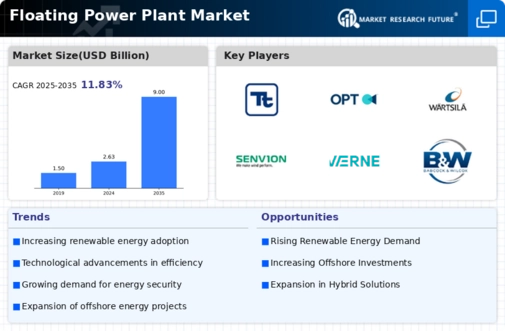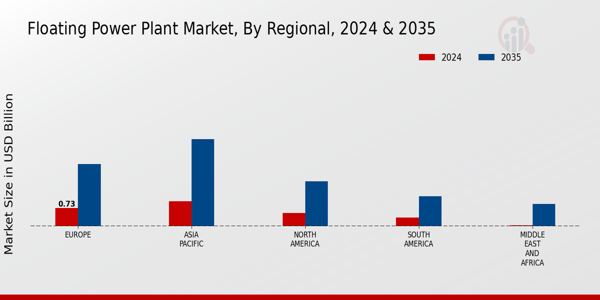Market Analysis
Floating Power Plant Market (Global, 2024)
Introduction
Floating Power Plant Market is expected to witness a substantial growth in the near future, as the demand for sustainable and renewable energy sources continues to grow. The floating power plant is a unique and efficient solution to harnessing the energy from various sources like wind, solar and wave. The world is in need of a sustainable solution to meet the growing energy demands and to meet the stringent regulations imposed by the environment. This new technology not only solves the problems of land-based power plants but also increases energy security and climate resilience. The Floating Power Plant Market is characterized by the presence of various players such as technology developers, energy producers, and regulatory bodies, all of which play a crucial role in shaping the future of the floating power plant. Floating Power Plant Market is expected to continue to gain momentum as the research and development continues to grow. As a result, the sector is expected to receive increasing attention from the private and public sectors.
PESTLE Analysis
- Political
- In 2024, the floating power plant market is strongly influenced by government policies aimed at promoting the use of clean energy. For example, the European Union has set a target of achieving 40 percent of its energy from renewable sources by 2030, which will require an investment of about 1 trillion yuan in the development of renewable energy. In addition, Japan and the United States have introduced favorable policies and regulations, such as tax deductions and subsidies, to encourage the development of floating power plants, which are expected to provide a solution to energy shortages and climate change.
- Economic
- By 2024, the economic situation for the floating power plants will be characterized by the rising level of investments in the renewable energy sources. In 2023, the total investment in the global renewals amounted to $500 billion. By 2025, the floating power plants could attract up to $30 billion of the total. In the last two years, the cost of the floating photovoltaic systems has been reduced by twenty percent, which makes them more profitable for both the public and private sectors. The further reduction in the cost is expected to be brought about by technological development and economies of scale.
- Social
- In 2024 the public acceptance of the floating power plants is growing. In coastal areas, 75 percent of the population is in favor of establishing a floating energy solution that can provide clean energy without using up valuable land. The 50,000 jobs created in the field of energy, especially in the construction and maintenance of the floating power plants, also contribute to the support and the social acceptance of the energy transition.
- Technological
- In 2024, technological developments are a critical factor in the market for floating power plants. And the invention of floating solar systems has made it possible to produce a maximum of 20 per cent more energy than the panels on the ground. This is because the temperature of the water is lower and therefore the efficiency of the solar cells is higher. Artificial intelligence and the Internet of Things have also made it possible to operate floating power plants more efficiently. Predictive maintenance has reduced downtime by a third. These technological developments are essential for the viability and attractiveness of floating power plants.
- Legal
- In 2024, the legal situation concerning floating power plants is evolving, and many countries are clarifying the rules to facilitate their operation. In the United States, for example, the permitting process for offshore wind power plants has been shortened from three years to less than a year. International treaties, such as the Paris Agreement, also continue to exert a significant influence on national legislation, requiring countries to adopt more ambitious emissions targets and to promote solutions based on renewable energy, including floating power plants.
- Environmental
- In 2024 the environment is the main factor in the floating power plant market. The installation of wind and solar energy systems is expected to reduce annual CO2 emissions by about one billion tons, thereby significantly contributing to the achievement of the global climate goals. The fact that the floating power plants can improve the local biotope by providing new living space for marine animals and that the majority of the projects report a positive effect on the environment will also be a decisive factor. This combination of energy production and environment protection is becoming more and more popular with the public and policymakers.
Porter's Five Forces
- Threat of New Entrants
- The barriers to entry into the floating power market are moderate, as the cost of developing the technology and constructing the necessary equipment is high. However, technological developments and growing interest in sustainable energy sources may lead to a moderate threat level.
- Bargaining Power of Suppliers
- Suppliers to the market for floating power plants, especially those that supply specialized components and technology, have little bargaining power. There are a large number of suppliers, which reduces the dependence on any one supplier and thus keeps their bargaining power low.
- Bargaining Power of Buyers
- The market for floating power plants is characterized by a high level of buyer power due to the availability of alternative energy solutions and the growing importance of cost-effectiveness. A greater number of companies and governments are seeking sustainable energy solutions, which enables buyers to negotiate better terms and prices.
- Threat of Substitutes
- There are other energy sources, such as wind and solar, but the unique advantages of floating power stations, such as the fact that they can operate on any waterway, can offset the threat of competition from alternative energy sources to some extent. But the increasing efficiency and falling costs of other alternative energy sources will continue to pose a medium-term threat.
- Competitive Rivalry
- Competition in the market for floating power stations is intense, driven by a large number of established and new players. The continuous development and improvement of the technology is a key element in the competition for market share, which in turn has led to a price war.
SWOT Analysis
Strengths
- Innovative technology that harnesses renewable energy from water bodies.
- Reduced carbon footprint compared to traditional power generation methods.
- Flexibility in deployment, allowing for installation in various aquatic environments.
Weaknesses
- High initial capital investment and operational costs.
- Limited awareness and understanding among potential customers.
- Technical challenges related to maintenance and durability in marine environments.
Opportunities
- Growing demand for sustainable energy solutions globally.
- Government incentives and subsidies for renewable energy projects.
- Potential for partnerships with marine and energy companies to enhance technology.
Threats
- Intense competition from other renewable energy sources like solar and wind.
- Regulatory challenges and environmental concerns regarding marine ecosystems.
- Economic fluctuations that may impact investment in new energy technologies.
Summary
Floating power plant market in 2024 is a unique blend of opportunities and strengths, especially in its approach to generating renewable energy and the increasing demand for sustainable solutions. However, the market faces major challenges, such as high costs and competition from other energy sources. Strategic alliances and government support can increase market penetration, but regulatory obstacles and environmental concerns must be overcome to fully exploit the potential of floating power plants.













Leave a Comment